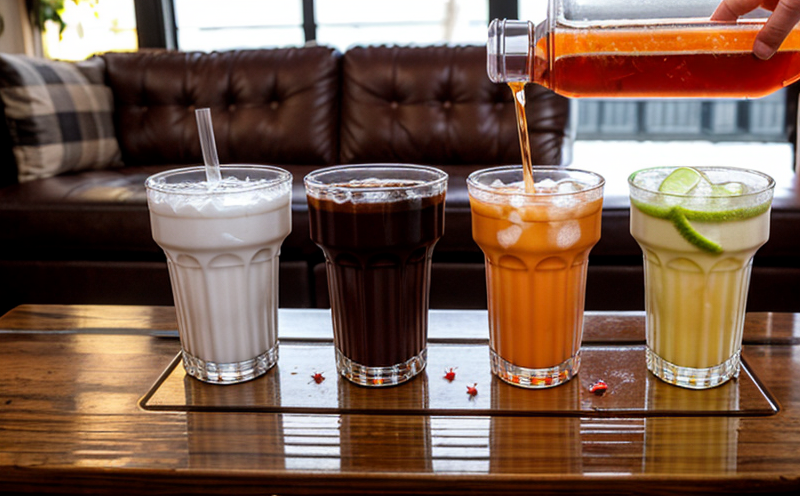ISO 8070 Chloride Determination in Soft Drinks
The determination of chloride in soft drinks is a critical analytical procedure that ensures product quality and safety. This process adheres to the ISO 8070 standard, which provides precise methodologies for chlorides analysis in beverages. Chlorides play a significant role in the taste profile and overall composition of soft drinks, influencing flavor and stability.
The presence of chloride can also indicate potential contamination from water sources or other ingredients. Thus, accurate measurement is essential to maintain product integrity and meet regulatory compliance requirements. The ISO 8070 method involves several steps: sample preparation, digestion, dilution, and finally, titration using a silver nitrate solution.
Accurate chloride determination requires meticulous attention to detail in each step of the process. Sample preparation is crucial; it involves filtering the beverage to remove any suspended particles that could interfere with the analysis. The filtered sample then undergoes digestion at elevated temperatures under acidic conditions, ensuring complete breakdown of organic compounds that might affect the test results.
Following digestion, the solution must be diluted accurately according to ISO 8070 specifications. This ensures that the chloride concentration falls within the linear range of the titration method used for accurate quantification. The final step is the titration process itself, where a standard silver nitrate solution is added until all free halides are precipitated as silver halide.
The endpoint of this titration is typically indicated by a distinct color change or turbidity. This reaction is reversible, and the chloride ion reacts quantitatively with silver ions to form insoluble silver chloride. The amount of silver nitrate required for complete precipitation directly correlates to the chloride content in the sample.
Once the endpoint is reached, the volume of silver nitrate used is calculated based on the titration curve or the point at which the color change occurs. This value allows for accurate quantification of chlorides present in the soft drink. The precision and accuracy of this method are paramount, as even small deviations can lead to significant discrepancies in reported chloride levels.
Understanding the implications of chloride content is essential for quality managers and compliance officers. Excessive chloride can indicate issues with raw materials or processing methods, necessitating process improvements. For R&D engineers, this test provides valuable insights into ingredient interactions and potential formulation adjustments. Procurement teams benefit from ensuring suppliers meet specified chloride limits to maintain product consistency.
The ISO 8070 method is widely recognized for its reliability and accuracy in determining chloride levels in soft drinks. Compliance with this standard ensures that the product meets international quality standards, enhancing consumer confidence and market acceptance.
Applied Standards
The ISO 8070 standard for chloride determination in beverages is widely recognized and applied across various industries. This method is not only used by soft drink manufacturers but also extends to other sectors where chlorine compounds are present, such as water purification and food processing.
The standard specifies the procedures for digesting samples under controlled conditions using nitric acid or sulfuric acid followed by titration with a silver nitrate solution. The accuracy of these methods is validated through rigorous testing against known standards.
Adherence to ISO 8070 ensures consistency in analytical results, making it easier for manufacturers to meet regulatory requirements and maintain product quality. This standardization also facilitates international trade by ensuring that products are consistently measured across different regions.
International Acceptance and Recognition
The ISO 8070 method is internationally recognized for its reliability in chloride determination, making it a preferred choice among food and beverage manufacturers worldwide. Its acceptance is widespread due to the stringent quality control measures it imposes on laboratories performing this analysis.
Countries that have adopted this standard include major global markets like the United States, Canada, Europe, and Asia-Pacific regions. By aligning with ISO 8070, companies can ensure their products meet international standards, thereby enhancing market competitiveness.
The widespread use of ISO 8070 also contributes to harmonization efforts among different national standards bodies. This convergence helps streamline regulatory processes and reduces the need for multiple certifications or tests when exporting goods internationally.
Use Cases and Application Examples
In practice, the ISO 8070 method is applied in various scenarios to ensure product quality and compliance with regulations. One common use case involves ongoing production monitoring, where periodic testing helps identify any shifts in raw material quality or processing conditions that could affect chloride levels.
Another critical application is during recipe development and optimization phases within R&D departments. By accurately quantifying chloride content early in the process, engineers can refine formulas to achieve desired taste profiles while maintaining product stability.
For procurement teams, implementing ISO 8070 ensures that suppliers adhere to specified limits on chlorides. This proactive approach helps prevent costly recalls due to non-compliant products and protects brand reputation.





